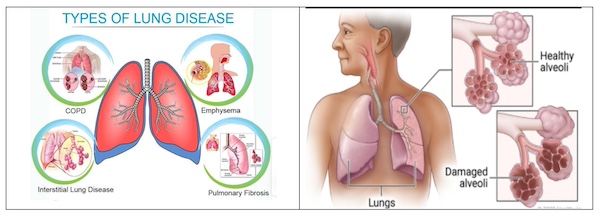Contribute
| Raising Awareness About Lung Diseases |
Dr. Indrajeet Tyagi and Dr. Iranna Hirapur
10/12/2025
Breath is a fragile vessel that carries our body from birth to death. The physiological process of breathing is carried out when Shuddha Vayu (oxygenated air) is inhaled, and Vishuddha Vayu (deoxygenated air) is exhaled. Shvasankriya or respiration consists of two alternative processes, i.e., Nishvas (inspiration) and Ucchvas (expiration). According to Chandogyopanishad, a human can survive without a body part such as eyes, hands, or legs but cannot function without two essential elements – breathing and food. The breath and food supply energy to all parts of the body. Prana, a sub-dosha of Vata, flows inwards towards the lungs and in turn it provides the human body with oxygen essential to sustain life. The Pranavaha Srotas or the transport system of Prana (vital energy of life), oxygen and vitality consists of several organs: Mukhavivara (mouth organ), Nasika (nose), Kantha (throat), Grasanika (pharynx), Swaryantra (larynx), Klomanadi (trachea), Apasthambh (bronchi), Phupphus (lungs). Lungs are the organs of life, working tirelessly to provide oxygen and remove waste gases from our bodies. Lung health is central to human well-being, yet diseases affecting the lungs continue to rise globally and remain one of the leading causes of illness and death worldwide. Millions of people live with chronic respiratory conditions; many do not realize it until the disease has progressed. From chronic conditions like asthma and Chronic Obstructive Pulmonary Disease (COPD) to life-threatening illnesses such as lung cancer and pulmonary infections, the impact is profound—not only on individuals but also on healthcare systems and economies. Raising awareness about lung health is therefore not just important—it is essential for saving lives. Despite this, awareness about lung diseases often remains limited, delaying prevention and timely treatment. In Ayurveda, respiratory and lung disorders are generally considered imbalances of the three doshas—Vata, Pitta, and Kapha—that affect the Pranavaha Srotas, the channels carrying the life force or prana rather than just an infection. Ayurvedic treatment focuses on rebalancing the specific doshas involved, clearing toxins (ama), and strengthening the respiratory system. Because according to Ayurvedic scholars the health of the respiratory system is interconnected with the state of the mind, metabolic functions (Agni), and the amount of toxins (Ama) in the body and partially influences one’s mental well-being, metabolism rate, and excretory functions. The impact of doshas on the lungs: The lungs are primarily governed by the Kapha dosha, which is responsible for moisture and lubrication. Poor digestion and diet can cause Ama/toxins to build up, obstructing the respiratory channels and leading to inflammation and poor lung function. Dosha Aggravating factors: Ayurvedic texts outline several specific factors that can disturb the doshas and contribute to lung diseases: Dietary errors: · Eating cold, heavy, or oily foods. · Consuming excessive dairy, sweets, and fried items. · Eating incompatible foods and practicing irregular meal habits. · Drinking cold water or beverages. Lifestyle choices: · Exposure to cold or humid environments. · Suppressing natural urges like sneezing, coughing, or urination. · Excessive or inappropriate physical exertion. · Lack of physical activity. · Smoking and exposure to smoke or dust (dhuma and raja). Psychological factors: Chronic stress and suppressed emotions can disrupt the mind-body balance and aggravate doshas, especially Vata. Environmental factors: · Exposure to air pollution, allergens, pollen, dust, and fumes can irritate the respiratory lining. · Sudden weather changes, such as cold winds Impaired digestion (Agni) and toxins (Ama) · Weak digestive fire (Mandagni) leads to the accumulation of Ama (undigested, toxic waste). · This sticky Ama clogs the internal channels, including the respiratory channels (Pranavaha Srotas), creating blockages and inflammation. Genetic predisposition: · A family history of respiratory conditions can increase susceptibility to developing a lung disease. According to modern medical science, the causes and risk factors for lung diseases are both preventable and non-preventable such as Smoking and exposure to secondhand smoke, occupational hazards such as dust, asbestos, and chemical fumes, air pollution—indoor and outdoor, genetic predispositions, respiratory infections during early life, and unhealthy lifestyle habits. Understanding Common Lung Diseases: Lung diseases are varied in their nature, causes, and severity. The most prevalent include: The two primary categories of lung diseases discussed in classical Ayurveda texts are Kasa (cough) and Shwasa (breathing difficulties). Kasa can be linked to infections or irritations of the respiratory tract, similar to the Western understanding of bronchitis. Shwasa category includes shortness of breath and the characteristic breathlessness and wheezing of asthma. While in modern medical sciences, Chronic Obstructive Pulmonary Disease (COPD) commonly caused by smoking and environmental pollutants, characterized by airflow obstruction, chronic cough, and breathlessness, Asthma, a long-term inflammatory condition of the airways that affects both children and adults, often triggered by allergens, dust, exercise, or pollution, Lung Cancer, Pulmonary Infections, Interstitial Lung Disease causing scarring (fibrosis) of lung tissue, resulting in progressive shortness of breath. Why Awareness Matters: Awareness is the first step toward prevention and effective management of lung diseases. Early detection significantly improves survival rates, particularly in conditions such as lung cancer and COPD, which often remain asymptomatic in early stages. Educating communities about risk factors, early symptoms, and treatment options empowers individuals to seek medical help promptly. Moreover, awareness campaigns reduce stigma associated with diseases like tuberculosis and provide much-needed emotional support for patients and families. Raising awareness about lung diseases is a moral and social responsibility. With effective prevention strategies, early diagnosis, and compassionate support systems, the burden of lung diseases can be significantly reduced. Strong lungs are essential for a strong future, and collective action today can ensure healthier generations tomorrow.
by Dr. Indrajeet Tyagi and Dr. Iranna Hirapur
You may also access this article through our web-site http://www.lokvani.com/
